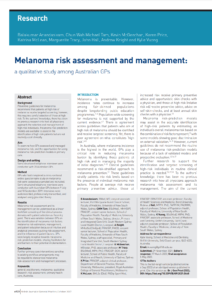 This qualitative study looking at understanding and describing melanoma risk assessment and management by Australia GPs was published in the British Journal of General Practice. (PDF | Web)
This qualitative study looking at understanding and describing melanoma risk assessment and management by Australia GPs was published in the British Journal of General Practice. (PDF | Web)
Anandasivam B, Tam CWM, McGeechan K, et al. British Journal of General Practice. 2022; 72(723): e737-e746. DOI: 10.3399/BJGP.2021.0668
Abstract
Background Preventive guidelines for melanoma recommend that patients at high risk of melanoma receive targeted screening; however, this requires careful selection of those at high risk. To the authors’ knowledge, there has been no previous research into how all physicians approach the selection and management of high-risk individuals. Melanoma risk-prediction models are available to assist in the identification of high-risk patients but are not routinely used clinically.
Aim To examine how GPs assessed and managed melanoma risk, and the opportunities for using melanoma risk-prediction models in primary care.
Design and setting Semi-structured telephone interviews were conducted with 20 Australian GPs.
Method GPs who had completed a cross-sectional online questionnaire study on melanoma risk were purposively sampled and recruited. Semi-structured telephone interviews were conducted with Australian GPs between 9 July and 10 September 2019. Interviews were audiorecorded, professionally transcribed, and analysed using grounded theory.
Results Melanoma risk assessment and its management can be understood as a linear workflow consisting of five clinical process domains with patient selection as the entry point. There was variation between GPs on the identification of melanoma risk factors, melanoma risk estimation, management, and patient education because of intuitive and analytical processes guiding risk assessment, and the influence of patient factors. GPs were largely receptive towards melanoma risk-prediction models, sharing facilitators for and barriers to their potential implementation.
Conclusion Further primary care interventions sensitive to existing workflow arrangements may be required to standardise melanoma risk-assessment and management processes.
